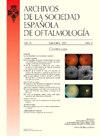使用3D广角扫描复视(3D WIDE SCAN REVIEW)对后葡萄根瘤进行病理性近视分类
Q3 Medicine
Archivos De La Sociedad Espanola De Oftalmologia
Pub Date : 2025-08-01
DOI:10.1016/j.oftal.2025.04.008
引用次数: 0
摘要
病理性近视与结构改变有关,包括后葡萄肿,可根据其形态进行分类。本研究旨在利用3d WIDE SCAN REVIEW扫描源光学相干断层扫描(OCT)平台对病理性近视患者的后葡萄肿进行分类,并将结果与Ohno-Matsui分类进行比较。患者和方法META-PM研究组进行了一项回顾性横断面队列研究,包括来自31名诊断为高度近视(眼轴长度≥26 mm和/或球等效≥- 6.00屈光度)和病理性近视(定义为等于或大于弥漫性脉络膜萎缩或存在后葡萄肿)的患者的59只眼睛。使用3d WIDE SCAN REVIEW分析,根据眼底凹陷的形状和外观对后葡萄瘤进行分类,并与Ohno-Matsui 2014分类进行比较。此外,使用萎缩-牵拉-新生血管(ATN)分类评估近视黄斑病变,明确评估萎缩(A)、牵拉(T)和新生血管(N)成分。使用Topcon Triton SCAN - source OCT系统进行图像采集,使用3d WIDE SCAN REVIEW平台对图像进行处理和分析。结果患者平均年龄49.56岁(SD:±18.50;71.05%的女性)。后葡萄肿的分布在研究人群中有所不同。I型(宽黄斑)最常见,占22.0%,其次是II型(窄黄斑)10.2%,III型(乳头周围)8.5%,IV型(鼻)3.4%,V型(下)8.5%。这种分类突出了病理性近视中黄斑病变的优势,鼻和下葡萄肿不太常见。在近视黄斑病变中,A1为最常见的萎缩性成分(43.5%),T0为主要成分(78.3%),N0为最常见的新生血管类型(83%)。结论3d WIDE SCAN REVIEW扫描源OCT平台为后葡萄肿的详细可视化和分类提供了一种高分辨率、无创的方法。通过使用Topcon Triton SS-OCT进行图像采集和3d WIDE SCAN REVIEW软件进行分析,本研究证明了一种临床可行的替代传统成像方式来评估病理性近视的后葡萄肿。本文章由计算机程序翻译,如有差异,请以英文原文为准。
Clasificación del estafiloma posterior en miopía patológica mediante 3 D WIDE SCAN REVIEW en imágenes del fondo de ojo
Introduction and objectives
Pathological myopia is associated with structural changes, including posterior staphylomas, which can be categorized based on their morphology. This study aims to classify posterior staphylomas in patients with pathological myopia using the 3 D WIDE SCAN REVIEW Swept-Source optical coherence tomography (OCT) platform and compare the findings with the Ohno-Matsui classification.
Patients and methods
We conducted a retrospective cross-sectional cohort study, including 59 eyes from 31 patients diagnosed with high myopia (axial length ≥ 26 mm and/or spherical equivalent ≥ −6.00 diopters) and pathological myopia, defined as equal to or greater than diffuse chorioretinal atrophy or the presence of a posterior staphyloma, according to the META-PM study group. Posterior staphylomas were categorized based on fundus depression shape and appearance using 3 D WIDE SCAN REVIEW analysis and compared using the Ohno-Matsui 2014 classification. Additionally, myopic maculopathy was assessed using the Atrophic-Tractional-Neovascular (ATN) classification, explicitly evaluating atrophic (A), tractional (T), and neovascular (N) components. Image acquisition was performed using the Topcon Triton Swept-Source OCT system, and images were processed and analyzed with the 3 D WIDE SCAN REVIEW platform.
Results
The patients’ mean age was 49.56 years (SD: ± 18.50; 71.05% women). The distribution of posterior staphylomas varied among the study population. Type I (wide macular) was the most prevalent, observed in 22.0% of cases, followed by Type II (narrow macular) at 10.2%, Type III (peripapillary) at 8.5%, Type IV (nasal) at 3.4%, and Type V (inferior) at 8.5%. This classification highlights the predominance of macular involvement in pathological myopia, with nasal and inferior staphylomas being less common. Regarding myopic maculopathy, A1 was the most common atrophic component (43.5%), T0 was predominant (78.3%), and N0 was the most common neovascular category (83%).
Conclusions
The 3 D WIDE SCAN REVIEW Swept-Source OCT platform provides a high-resolution, non-invasive method for detailed visualization and classification of posterior staphylomas. By using Topcon Triton SS-OCT for image acquisition and 3 D WIDE SCAN REVIEW software for analysis this study demonstrates a clinically viable alternative to traditional imaging modalities for evaluating posterior staphylomas in pathological myopia.
求助全文
通过发布文献求助,成功后即可免费获取论文全文。
去求助
来源期刊

Archivos De La Sociedad Espanola De Oftalmologia
Medicine-Ophthalmology
CiteScore
1.20
自引率
0.00%
发文量
109
审稿时长
78 days
期刊介绍:
La revista Archivos de la Sociedad Española de Oftalmología, editada mensualmente por la propia Sociedad, tiene como objetivo publicar trabajos de investigación básica y clínica como artículos originales; casos clínicos, innovaciones técnicas y correlaciones clinicopatológicas en forma de comunicaciones cortas; editoriales; revisiones; cartas al editor; comentarios de libros; información de eventos; noticias personales y anuncios comerciales, así como trabajos de temas históricos y motivos inconográficos relacionados con la Oftalmología. El título abreviado es Arch Soc Esp Oftalmol, y debe ser utilizado en bibliografías, notas a pie de página y referencias bibliográficas.
 求助内容:
求助内容: 应助结果提醒方式:
应助结果提醒方式:


